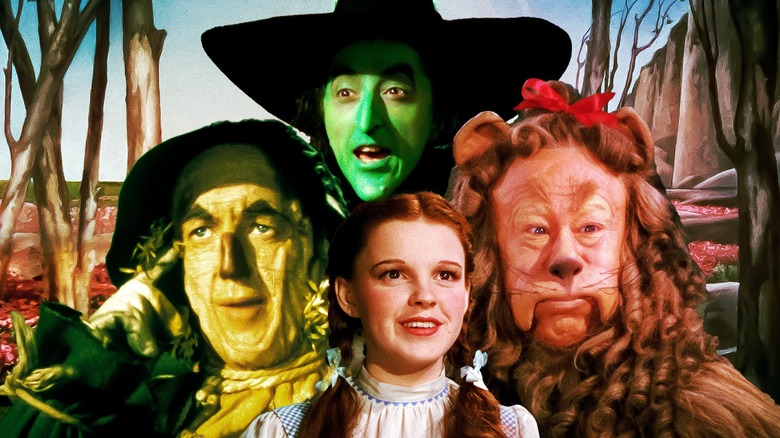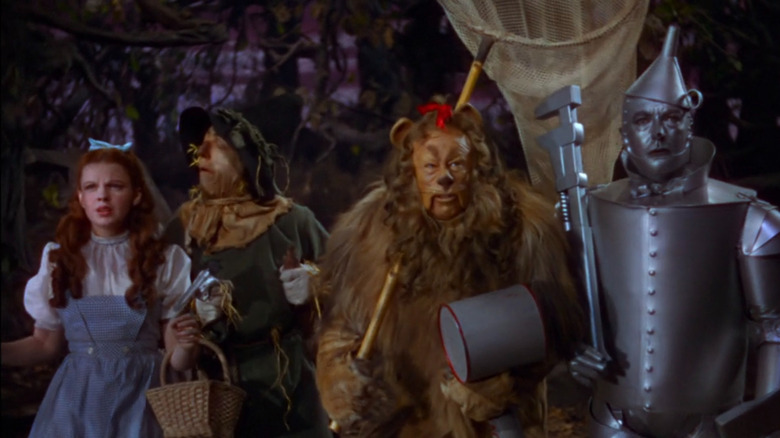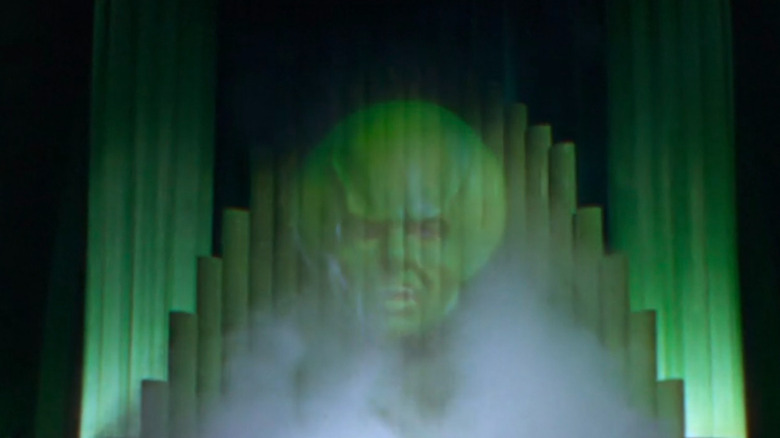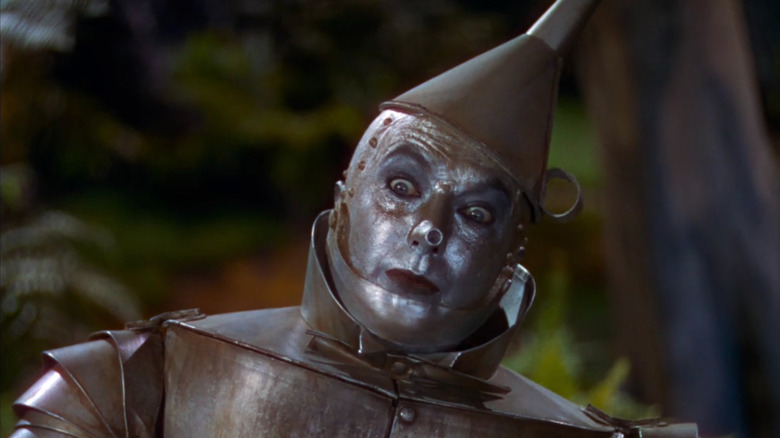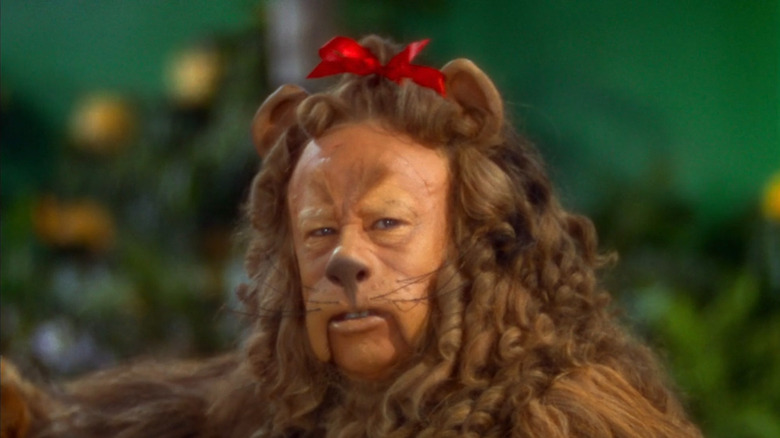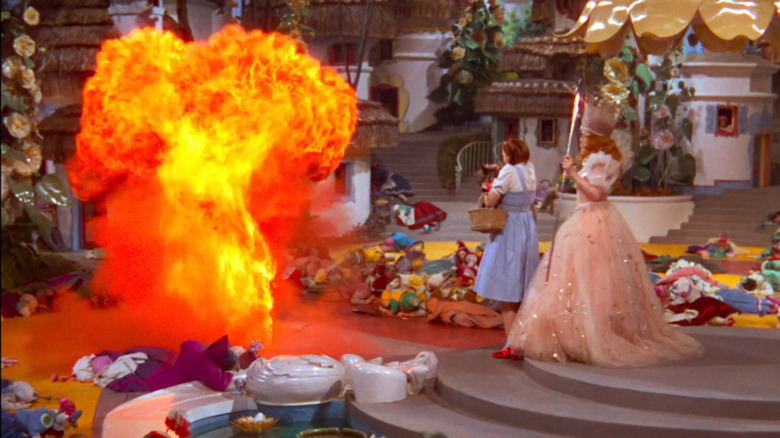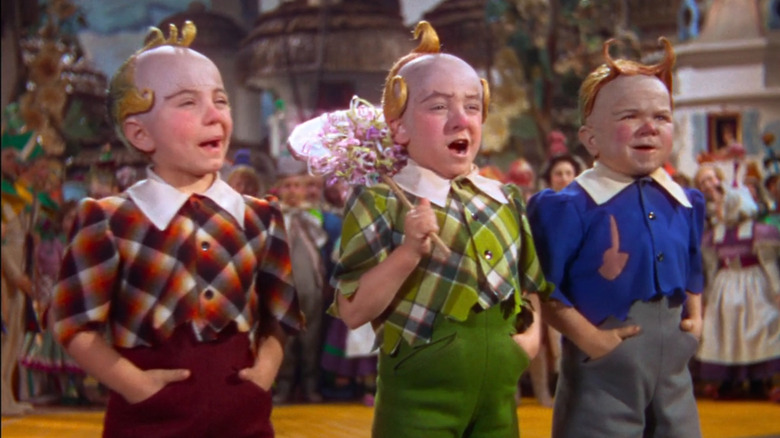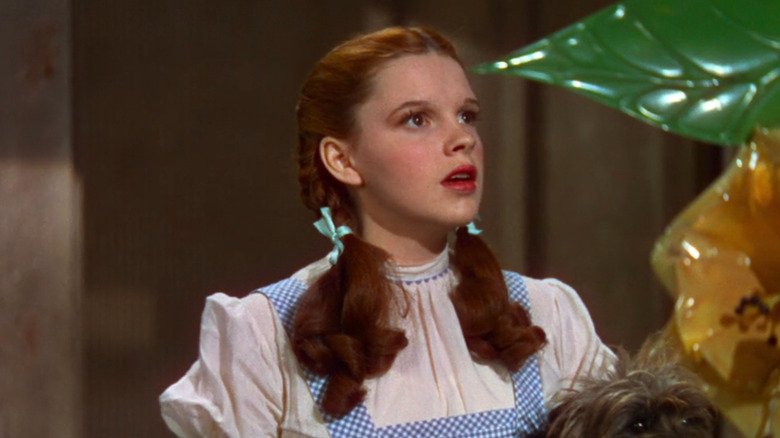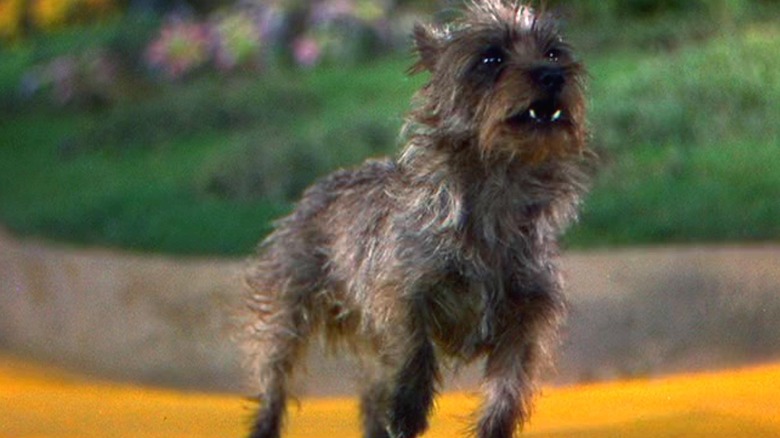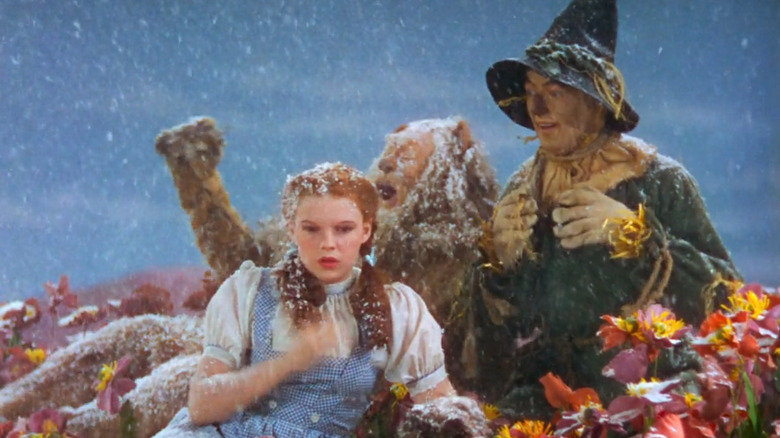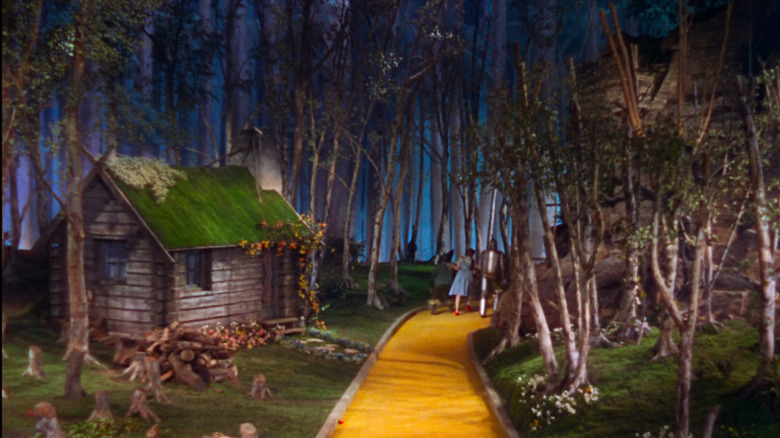The Entire History Behind Wizard Of Oz's Nightmarish Production Explained
Very few films go hand-in-hand with the word "iconic" quite like the 1939 cinematic adaptation of L. Frank Baum's "The Wonderful Wizard of Oz." It is quite telling that when most people think of Baum's classic fantasy story, the classic film adaptation is usually the first version of the story that comes to mind. "The Wizard of Oz" is one of the most charming films in all of cinematic history, which makes the various stories behind its arduous production all the more shocking.
Yes, behind all of the happy songs and technicolor rainbows that audiences see in the finished version, there was a production rife with intense drama and various pitfalls. From allergic reactions to a conveyor belt of changing directors to on-set injuries, it wouldn't be unfair to compare the production to an actual twister. Given the film's age — it is now officially over 80 years old — much of the information about these behind-the-scenes details comes from books and various bits of archived material.
With that in mind, here are just a few facts that'll shine a light on the nightmarish production of "The Wizard of Oz."
The script went through endless changes
A screenplay is truly the lynchpin of any given film's success because if the script is broken, then the movie itself is bound to be subpar. When it came to bringing "The Wizard of Oz" story to screen life, nailing the script was the first step in achieving a smooth production. However, it seemed that even this step proved quite difficult as, according to "The Making of The Wizard of Oz" by Aljean Harmetz, the script went through many changes before shooting even began.
Originally, the fantasy elements of the story were heavily toned down, due in major part to the lukewarm reception to fantasy films of the era. As the scripting process went on, multiple writers were crafting different screenplays for the film at the exact same time. This meant that the likes of Herman J. Mankiewicz, Noel Langley, and poet Ogden Nash were penning completely different visions and were never made aware by the studio.
By the time a finished version was completed, it was essentially an eclectic hodgepodge of the various scripts. Watching the film today, audiences might really have no idea that the script went through such a tedious revision process. However, this was just the start of the many changes to the film's behind-the-scenes structure that were on the way.
The film had several different directors
Throughout the production of "The Wizard of Oz," the film's director chair was actually filled by a few different people at different times. Per a 1998 article from the St. Louis Post-Dispatch, it was confirmed that a total of four different directors took over production at various points in the production process. Richard Thorpe first got things rolling as things kicked off at the end of 1938, but he only helmed the production for roughly two weeks of shooting. He'd only get as far as Dorothy's first scene with the Scarecrow and her rescue from the Wicked Witch of the West's castle before being replaced.
Following Thorpe's dismissal, director George Cukor briefly took over production, and he actually accomplished a fair bit during his expedited tenure. This included changing Judy Garland's hair and wardrobe to reflect her actual appearance, as well as recommending Jack Haley as a replacement for the character the Tin Man. After guiding the film's already-troubled production, Cukor bequeathed the reins to director Victor Fleming, who remained the film's main director for the majority of its production.
Despite a heap of other issues, Fleming was able to perform his duties and get most of the film in the can. However, at the tail end of production, Fleming was forced to depart due to being needed for "Gone With The Wind," where he once again stepped in for George Cukor. This meant that Fleming's associate, King Vidor, had to step in and finish off the film's remaining few sequences, including Dorothy's now-iconic "Over the Rainbow" scene.
The Tin Man's makeup incident
So far, many of the things we've covered, including screenplay delays and directorial issues, have been fairly common movie-making pitfalls. However, it's here that we can begin delving into the incidents that really propelled the "Wizard of Oz" production into infamy. We can start with the original actor tasked with bringing the Tin Man to life, Buddy Ebsen, and why he was forced to leave the film. Ebsen is perhaps best known for his work as Jed Clampett, the protagonist of "The Beverly Hillbillies" sitcom series on CBS. However, for a sizable chunk of time, Ebsen was the man who was set to bring the Tin Man to life for "Wizard of Oz." This has been confirmed by various images of makeup tests, as well as on-set photos of Epsen with the rest of the cast.
Unfortunately, not too long into his stint as the character, Epsen soon became struck down with respiratory issues due to his makeup. It seems that the Tin Man's makeup contained toxic aluminum dust that, when inhaled, caused Epsen to endure intense allergic reactions. Epsen even recounted in his own autobiography, "One night in bed I woke up screaming. My arms were cramping from my fingers upward and curling simultaneously so that I could not use one arm to uncurl the other." So, following this experience, Epsen was understandably benched from the film, leaving Jack Haley to step in to take over the role.
The other character's makeup
It wasn't just Buddy Epsen who suffered due to the quality of the makeup and wardrobe on the set of "The Wizard of Oz." Let's start with the costume and makeup worn by Bert Lahr in his role as the Cowardly Lion. Lahr's facial expressions and comedic timing, when paired with his attire, made for one of cinema's funniest performances, but that didn't mean he wasn't struggling.
It's been long confirmed through auction listings that his Cowardly Lion costume was constructed from real lion skin and hair. The documentary, "The Wonderful Wizard of Oz: 50 Years of Magic," noted that the suit's less-than-breathable nature didn't mesh well with MGM's hot studio lights — making it quite the physical strain for Lahr. However, it didn't stop there, as there was also poor Margaret Hamilton, who truly suffered for her art on set. As confirmed by "The Making of The Wizard of Oz," not only did her green copper-based makeup make it a challenge to eat, but it was just as annoying under the hot lights as well.
One must hand it to Margeret Hamilton, as the level of frustration this woman was willing to slog through was fairly substantial. Still, it's not like the production became so chaotic that it resulted in her on-set injury, right? Wrong...
The Wicked Witch's fiery incident
There's a strong case to be made for the Wicked Witch of the West being regarded as one of the greatest villains ever put to film. For many young children, Margaret Hamilton's performance, for as campy as it is now, was truly the height of formative nightmare fuel. So much so that a cameo from Hamilton done in character many years later on "Sesame Street" resulted in the series' only banned episode (via NBC News).
Many will remember that when making her exit from Munchkin land, the Wicked Witch disappears in a burst of fire. The way this effect was achieved by Hamilton exiting via a trap door opening as the flames shot up to hide the seams. However, as explained in "The Making of The Wizard of Oz" and interviews with Hamilton, things quickly became life-threatening. During her exit, the flames became too intense, which left Hamilton with second- and third-degree burns on her face and hand — leaving her to heal at home for six weeks. She was later quoted as saying, "I won't sue, because I know how this business works, and I would never work again. I will return to work on one condition — no more fireworks!"
It's also worth noting that Betty Danko, Hamilton's stunt double, was also horribly injured as well when a smoking pipe meant to be the Witch's broom exploded and permanently scarred her legs.
The alleged behavior of the Munchkins' actors
For those not in the know, one of the most persistent rumors surrounding "The Wizard of Oz" was the wild behavior of the various actors playing the Munchkins: Simply put, it's been alleged that the small-statured actors playing the residents of Munchkinland were far from the easiest group to corral.
Bert Lahr, in his autobiography, noted, "Assistants were ordered to watch the crew of midgets, who brandished knives and often conceived passions for other, larger Metro personnel."
Additionally, Judy Garland even commented on their behavior in an interview, confirming a time when one of them asked her out. Garland said that she didn't want to reject him simply for being a small person, so she noted that her mother wouldn't approve, to which he responded, "Ah come on, bring your ma too!" She'd also jokingly add the Munchkin actors would get drunk at the hotel they were staying at and needed to be wrangled with butterfly nets.
Later on, another version of these stories emerged via the memoir of Garland's ex-husband, Sid Luft wherein he was a bit harsher. He mentioned, "They would make Judy's life miserable on set by putting their hands under her dress." This story has never been confirmed by anyone else, so there's a good chance it was fabricated by Luft. While it has been loosely confirmed that the Munchkin actors could get a bit raucous, their various misdeeds it seems are largely unsubstantiated.
The treatment of Judy Garland
At the center of "The Wizard of Oz" was a 17-year-old Judy Garland, set to step into Dorothy Gale's ruby slippers. Nowadays, one can't imagine the film without Garland's kind smile, bright eyes, wholesome delivery, and her now-iconic singing voice. Unfortunately, underneath all the rainbows and poppy fields, is a much darker story that reveals the long-standing dark nature of Hollywood.
Time Magazine confirmed that, due to the comedic timing of Bert Lahr, Garland couldn't stop laughing during one particular take. This led to director Victor Fleming taking her aside to slap her across the face in order to get the scene done. Additionally, it's also been reported that Garland was subjected to even further physical abuse by Louis B. Mayer, the co-founder of MGM studios (via The Washington Post). Biographer Gerald Clarke, the author of "Stay Happy: The Life of Judy Garland," uncovered much of the information surrounding these claims when he found Garland's own unpublished memoir.
Also, per the same biography, Garland had been hooked on energy pills from as early as age 10 due to her mother. This was something that persisted throughout her entire acting career, even on the set of "The Wizard of Oz," with Garland constantly being handed uppers, downers, and even Benzedrine, a diet pill, throughout the shoot. Additionally, due to Dorothy's young age in the film, MGM saw it necessary to strap Garland's breasts down with a corset.
If you or someone you know may be the victim of child abuse, please contact the Childhelp National Child Abuse Hotline at 1-800-4-A-Child (1-800-422-4453) or contact their live chat services.
If you or anyone you know needs help with addiction issues, help is available. Visit the Substance Abuse and Mental Health Services Administration website or contact SAMHSA's National Helpline at 1-800-662-HELP (4357).
Toto's onset injury
"Toto, I have a feeling we're not in Kansas anymore. To this day, that's one of the first lines that anyone thinks of when they remember "The Wizard of Oz." This is what Dorothy says to her only companion when she first arrives in the Land of Oz, her tiny canine named Toto. It's been explained in the pages of "The Making of The Wizard of Oz," that Toto was played by a female Cairn terrier named Terry. Sadly, it seems that not even tiny little Terry could make it offset without some form of calamity, suffering his own injury as well.
It's been written that Terry was accidentally jumped on by an actor playing one of the Wicked Witch of the West's many soldiers. This resulted in Terry being pulled from the production and her on-set trainer Carl Spitz scrambling to find a replacement. Fortunately, Terry was able to return to her duties just a few weeks later and was able to finish her role in the film.
What the snow was made out of
Partway through the film, Dorothy and her friends take a jaunt through a poppy field en route to Emerald City. This is soon revealed to be yet another devious trap, courtesy of the Wicked Witch of the West. Both Dorothy and the Cowardly Lion are lulled into a sleep state while the Tin Man and Scarecrow, who are unaffected by the field due to their non-biological makeup, yell for help. Fortunately, Glinda the Good Witch hears them and sends a quick snowstorm to defuse the poppy's magic, waking up Dorothy and the Lion.
However, it's worth discussing what the snow itself was made out of and why, with the benefit of hindsight, it was so dangerous. It's been confirmed in the years since the release of "The Wizard of Oz," that the snow used on-set was actually made of asbestos. This has been substantiated, not only in documentaries but in the pages of "The Making of The Wizard of Oz" as well.
The Asbestos website provides a very detailed account of asbestos' history and its once-longstanding status as a "miracle fiber," going as far back as the late-1800s. Basically, the substance's fibers contained negligible doses of dangerous carcinogens, ones that could cause respiratory issues if exposed for too long.
The hanging Munchkin urban legend
The internet is a tricky place, as you can start up just about any substantiated rumor and have people buy into it hook, line, and sinker. Case in point: the curious case of "The Wizard of Oz" and a Munchkin who apparently hung himself in the background of a scene. Yes, for years, website after website helped to substantiate a long-lasting urban legend that if you look closely in the background of a key yellow brick road scene, you can see what appears to be a Munchkin plunging to their death. For many, this is one of the earliest examples of being fed a lie by the internet and running with it.
However, as many have pointed out, this rumor is simply that: a rumor that has ballooned way out of hand. There is no written source in either an interview or any article written at the time (or since) regarding the on-set death of one of the Munchkins. In more recent releases of "The Wizard of Oz," one can easily see that the "hanging Munchkin" is simply a bird flapping its wings in the background. Given how many people first saw the film on TV or on home video, it's possible it might have been misconstrued due to the low-grade video quality. You can call foul on a lot of what happened behind the scenes in this film, but a munchkin hanging isn't one of them.
Still, the sheer lasting ubiquity of this rumor is one of many signals that "The Wizard of Oz" is and will always be one of the most storied movies in Hollywood history.
If you or someone you know is struggling or in crisis, help is available. Call or text 988 or chat 988lifeline.org
